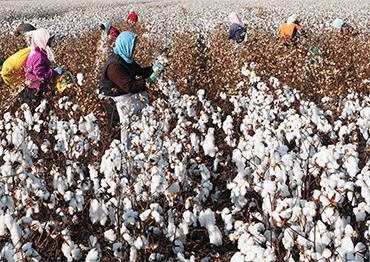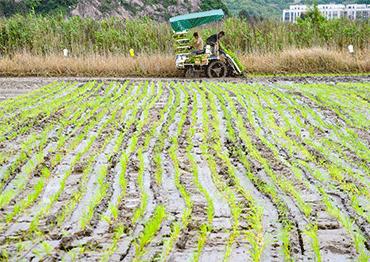alinized soil refers to soil with high concentrations of salt and/or sodium ions, which inhibit the absorption and flow of water for plants, causing declining crop yields and the deterioration of the surrounding ecosystem. It is found on all continents, forming a major challenge globally for food security and environmental protection, according to the Food and Agriculture Organization of the United Nations.
In China, some 100 million hectares of soil are salinized, the third-largest area in the world. About one-third has the potential to be developed for agricultural purposes, according to researchers. The salt-affected soil in China is mainly located in the country’s eastern coastal areas and the arid and semi-arid north.
For three years since 2022, China’s No.1 Central Document, which for decades has been the country’s most important annual policy paper for the development of agriculture, rural regions and farmers, has prioritized the remediation and reclamation of salinized soil, stressing the strategic significance of the task for national food security and environmental protection.
Soil salinization is caused by intrusion of water from the sea, rivers and groundwater, as well as mismanagement of agricultural processes, such as excessive use of mineral fertilizers. Growing salt-tolerant rice has proved an effective way to remediate the soil and turn it into productive arable land.
In recent years, China has been promoting the cultivation of salt-tolerant rice, also called seawater rice. In 2023, Jilin was the fourth-largest grain producer in China, and 86 percent of Jilin’s new arable land came from salt-affected soil during the 13th Five-Year Period (2016-2020), according to the provincial Department of Agriculture and Rural Affairs.
Ma Wei, an associate research fellow at the Jilin Academy of Agricultural Sciences who holds a doctorate in crop science, has been researching rice cultivation on salinized land in western Jilin province in China’s northeast for a decade. He shared his experiences and views on China’s efforts to deal with salinized soils.
China News Service: Can you describe how China is trying to deal with salinized soil based on your own experience in working on the salt-affected soil in western Jilin Province?
Ma Wei: China has launched rounds of large-scale actions in a bid to remedy salt-affected soil and turn it into reserve arable land. More than 40 applied techniques under eight categories, such as techniques to reduce salt concentrations in the soil, have been developed. More than 50 salt tolerant crop varieties have been promoted around the country. All these scientific techniques have proved effective after being trialed. Between 2020 and 2022, a trial project on remediation and reclamation of salinized soil was conducted under the auspices of the Ministry of Agriculture and Rural Affairs in eight provinces.
China has adopted two technical paths to remedy salinized soil. One focuses on improving soil conditions by installing more irrigation and drainage facilities or adding supplements to the soil, so that salt concentrations can be reduced enough to allow for crop growth. The other focuses on breeding crop strains which can grow in salinized soil without remediation of the soil. China’s experience has proved that both ways need to be used in tandem to restore soil fertility as much as possible.
The soda-saline soil in China’s northeast, one of the major salt-affected areas in the country, is found in the cities of Baicheng and Songyuan in western Jilin, and Daqing and Qiqihar in neighboring Heilongjiang Province. It is also one of the three major soda-saline lands in the world. The salt content here is composed of soda (sodium carbonate) and sodium bicarbonate. It is high in pH, salt concentration and sodium, but low in organic matter and water permeability. It is the most difficult salinized soil to deal with.
No matter which technical path or improvement measures are taken, the key is to choose the best way based on the soil conditions. This is true anywhere in the world. I have been working in Zhenlai County of Baicheng City in Jilin Province. Numerous experiments and practices conducted by the Jilin Academy of Agricultural Sciences have proved that rice cultivation is an effective way to improve the condition of soda-saline soil. In 1989, the Jilin Academy of Agricultural Sciences proposed a plan to grow rice to remedy the salt-affected land, thus preventing floods and creating wealth.
This option is based on local natural resources. There are scattered wetlands and lakes all over Jilin’s west, where several rivers converge. Through our practice, we found the right way, which is to grow rice where there are fresh water supplies and to channel that water to the paddy field. This right choice paved the way for our success.
In recent years, we’ve been paying more attention to integrating techniques to achieve optimal results through improvements to soil condition, seed varieties and technical advances.
In 2007, Jilin implemented a mega project to improve soil conditions in its west. As part of the project, research institutes and land improvement enterprises within and outside Jilin worked together on systematic research and development of selection and breeding salt tolerant seeds, soil improvement techniques and salt tolerant cultivation techniques. In 2015, the model of yield improvement through the integration of soil and crop cultivation techniques, which was jointly developed by the Northeast Institute of Geography and Agroecology of the Chinese Academy of Sciences and Jilin Academy of Agricultural Sciences, won second prize for national sci-tech progress (one of the five national prizes for sci-tech breakthroughs of the year).
CNS: Is it possible to turn salinized soil into fertile arable land at large scale in other parts of the world?
MW: This is an absolutely attainable goal. Many countries are taking action to address the threat of expansion of salt-affected soil to agricultural production, land values and water resources. A lot of practices and measures have been worked out to develop and remedy salinized soil.
For example, Australia tried to slow the process of salinization or sodicity (sodium levels) in soil through management of soil and crop planting techniques. It has also made great efforts on the assessment, selection and seed breeding of crop varieties which are tolerant to salt, sodium and other ions (like potassium, chloride or sulfates). In India, gypsum is used to improve soil condition, and the rice-fish system (an ecological symbiosis in which fish are raised in a paddy field) is also used to facilitate water drainage and slow the salinization of coastal soil. In the Netherlands and Israel, various techniques are used to control and reduce salt in the soil. Saudi Arabia and the United Arab Emirates focus on breeding more plant varieties which are tolerant to high salt content. In Egypt, micro-organisms in the salt-affected soil are being used to improve it.
Practice has proved that reasonable development and treatment of salinized soil, no matter what techniques are adopted, will not only increase the area of crop land, but also improve the ecological environment and maintain stable ecosystems. Take the soda salt-affected soil in China’s northeast. After decades of efforts by several generations, the soil has become one of the major arable land reserves for development and a big contributor to Jilin’s vision of having a 50-billion-kilogram annual grain output by 2030 (an increase of about 10 billion kilograms compared with the yield in 2023). For example, Zhenlai County (which hardly had any rice yield before the campaign of remediation and reclamation of salt-affected soil was started there in the 1980s) had 103,333 hectares of rice fields in 2023, the largest in Jilin, which yielded 1.03 billion kilograms of rice, the champion of the province for five years in a row.
CNS: What can China contribute to the world’s efforts on remediation and reclamation of salinized soil and how should countries around the world strengthen international cooperation on this issue?
MW: Frankly, China is home to 20 percent of the world’s total population, who live on only 9 percent of the world’s arable land and 6 percent of the world’s fresh water. The country has made the historic achievement of overcoming famine by providing its huge population with first an adequate food supply, and then an abundant supply of good quality food. This achievement itself is a huge contribution to global food security.
Regarding the remediation and reclamation of salinized soil, no country can boast that it has the world’s best practice. Countries with such soil are all making consistent efforts to address the challenge. Each has its unique advantages and challenges due to its geographic, climate, political and economic conditions.
China has benefited from the experience of other countries and provides its own effective practices to other countries. For example, some rice seeds have been introduced into China from Italy, Japan, South Korea and the US to detect their salt-tolerant genes and create new salt-tolerant varieties.
In recent years, China has been providing advanced agricultural techniques and experience, including those for remediation and reclamation of salt-affected soil, to countries within the Belt and Road partnership. The techniques and experience have proved effective in those countries. I think it is crucial to build a platform for international cooperation. It means exploration of closer cooperation beyond international conferences for exchanges of experience and research development. For example, joint labs can be built where experts from different countries can work together to address salinized soil.

 Old Version
Old Version



